9 Types of Software Development

Key takeaways
- Explore different types of software development such as web, mobile, game, cloud development, and many others to get a comprehensive overview of all the nuances and intricacies of the digital product creation.
- Learn about development methodologies like security engineering and DevOps engineering that can help speed up the development process and enable top-notch security for your project.
- So, how do figure out how many types of software engineers you need for your project? Continue reading our article to learn how to make the right decision.
The right approach to product creation from the business owner’s side involves familiarity with various software development types and their application areas. The technology and development approach that enables the analysis and processing of large datasets differ from those required to build a social media platform such as Instagram. They will also be different for the creation of a fitness tracker, a smart thermostat, or an e-commerce application.
Branches of software engineering differ in terms of their purpose, the tech stack most commonly used, specifics, and other parameters, and it’s crucial to understand the nuances before the start of the development. Our goal is to provide insights into the basics of software development, help you choose the right type for your project, and understand what types of specialists are needed to bring your idea to life.
9 types of software development
Creating a software solution that meets business objectives requires a strategic approach. Therefore, understanding the different types of development is essential for entrepreneurs. It allows companies to align their development approach to the specific requirements and nature of the project. Types of development, such as web, mobile, or embedded development, have their own challenges and opportunities, and a customized approach enhances the effectiveness of the project. Different software development types come into focus when deciding to develop your project, and each of them needs a personalized strategy that addresses its unique requirements.
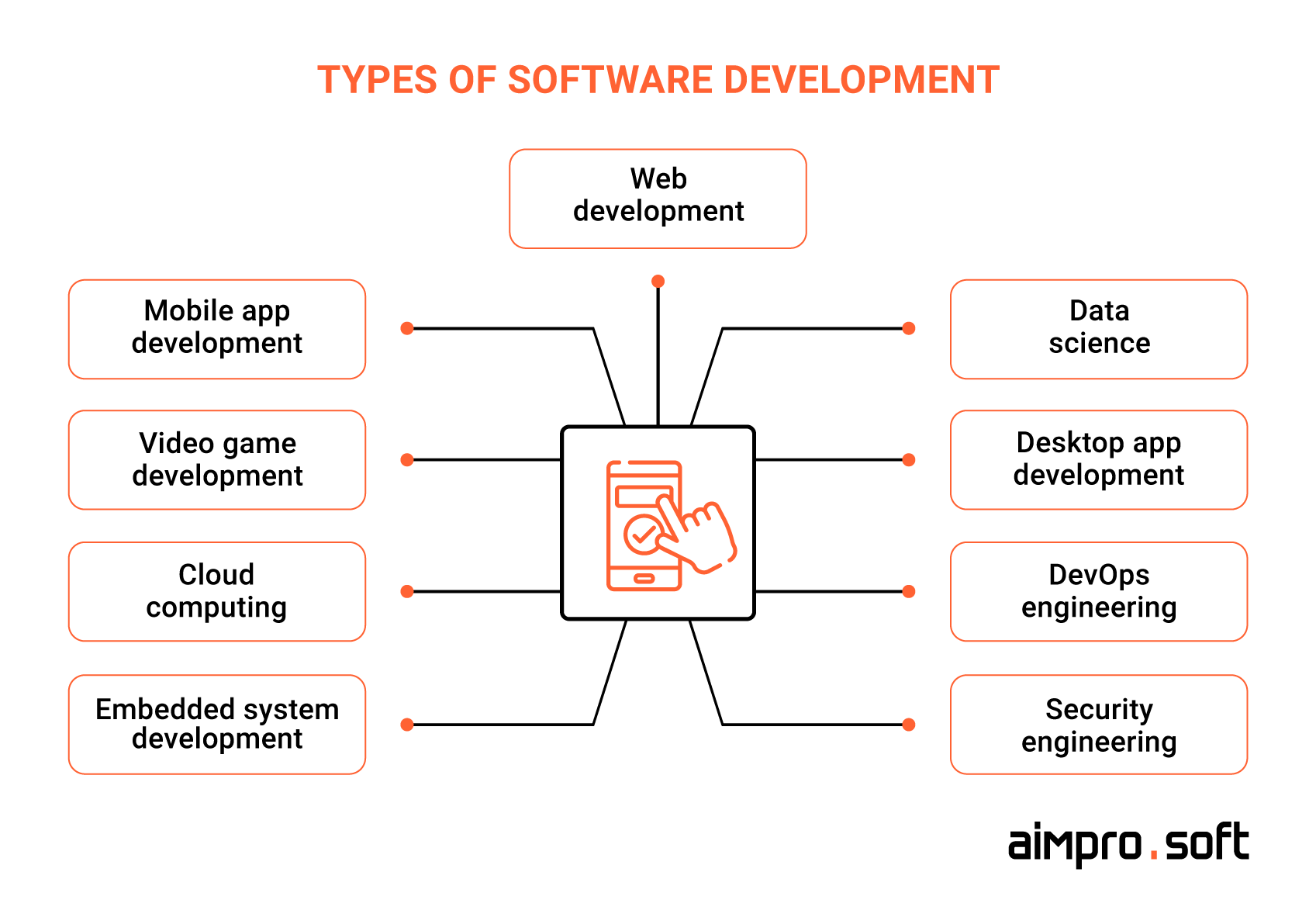
Types of software development
Web development
Web development, or website development, encompasses the processes involved in creating, constructing, and maintaining web applications accessible through a browser. This multifaceted development area includes aspects such as web design, web programming, and database management. In the context of web development, web applications are a category of apps that are accessed through an internet browser on various devices such as smartphones, laptops, tablets, or desktop computers. Unlike traditional websites, web applications are dynamic, respond to user input or actions, and operate in real-time without requiring downloads or manual updates.
Web development is characterized by scalability, accessibility, and cross-platform compatibility, allowing a new product or service to be brought to market quickly. Continue exploring this section to find out the main categories into which web development is usually broken down.
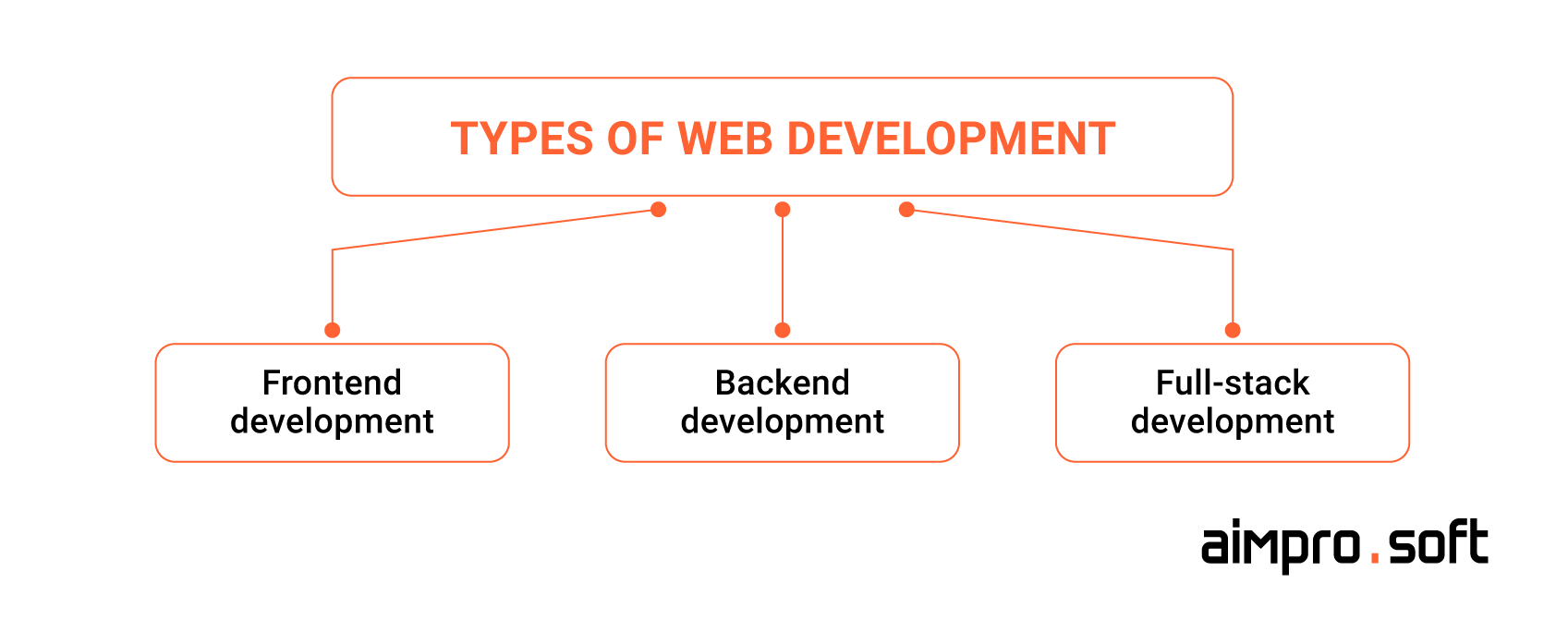
Types of web development
Front-end
Front-end development is the process of creating the user interface and crafting the user experience for web applications. It involves implementing visual elements that users directly interact with, including layout and responsive elements. Front-end developers aim to create an engaging and intuitive interface, using technologies such as HTML for structure, CSS for styling, and JavaScript for interactivity.
What type of projects is front-end development required for?
Front-end development is suitable for almost all projects, namely solutions with user interface (UI) and user experience (UX) of a website or web application. Frontend development is unnecessary only in cases where internal services, APIs, or server-side processes may not have an external interface. These components are mainly engaged in data processing, database management, or background tasks, and users can interact with them directly through other applications or services.
What kind of specialists are involved in front-end development?
- Front-end web developer
This specialist implements visual and interactive elements on web pages, ensuring a seamless user experience. Specializes in coding interactive features using technologies such as JavaScript, enhancing the functionality of web pages.
- UI/UX designer
Designer creates wireframes and prototypes to outline web pages’ or applications’ structure and functionality. Utilizing design editing software, UI/UX designers craft visually appealing and convenient interfaces, considering layout, color schemes, and typography.
Back-end
Back-end development focuses on the server side of applications. This includes server-side programming, handling databases, and ensuring the product’s security, scalability, and performance. Back-end developers work behind the scenes, managing data storage, server logic, and APIs. Some of the popular technologies commonly applied in back-end development include Node.js, PHP, Java, Python, and Ruby on Rails.
What type of projects is back-end development required for?
Back-end development is required for many projects that require complex data processing, storage, and management. It becomes necessary when applications require dynamic content delivery, user authentication, and database interaction. In cases where user input or actions affect data presentation, backend development is essential.
However, not every project requires a separate backend. Static websites or simple information platforms can function effectively only based on the front-end, as they assume minimal user interactivity and data manipulation.
What kind of specialists are involved in back-end development?
- Back-end developer
The backend developer writes server-side code, develops databases, and handles the application’s logic.
- Server administrator
This expert manages and maintains server infrastructure, including server deployment, configuration, and optimization.
- Software architect
Software architect chooses the most relevant tech stack and development approach and designs the overall architecture of the system, making high-level decisions on how different components will interact.
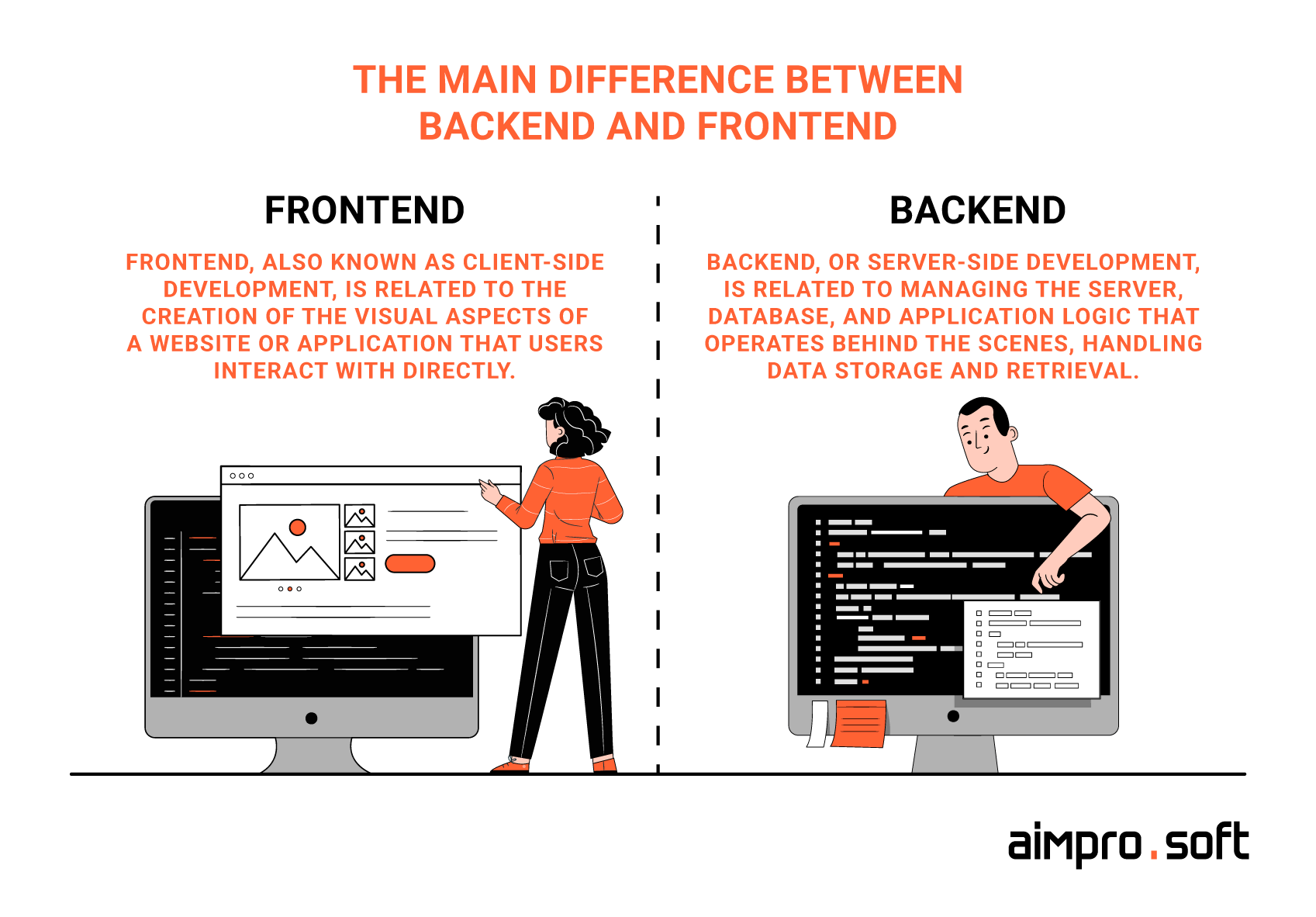
The main difference between backend and frontend
Database development
Database development is a category of backend development that revolves around designing, implementing, and maintaining databases to store and retrieve data efficiently. It encompasses tasks such as database modeling to define the structure, querying to retrieve specific data, and optimizing performance. Popular database management systems utilized in development include MySQL for relational databases, PostgreSQL for advanced functionality, and MongoDB for NoSQL databases.
What type of projects is database development required for?
Database development provides efficient storage, organization, and processing of data, which is important for various types of applications and business systems. Database development is required for projects, including enterprise resource planning (ERP) systems, financial systems, telecommunication systems, data warehousing and business intelligence systems, and supply chain management systems.
Database development becomes optional for straightforward applications or websites that don’t involve data storage or retrieval. Examples include static websites or landing pages designed solely for displaying information without user interaction or data processing manipulation.
Which specialists are involved in the development of databases?
- Database developers
These professionals focus on designing data schemas, writing SQL queries, creating stored procedures, and ensuring database efficiency.
- Database administrator (DBAs)
Database admin designs, implements, and maintains the database system, ensuring efficient data storage and retrieval.
- Data architects
Design the overall data architecture, define data models, and develop data management strategies.
API development
API development is another category of backend development that involves the creation of Application Programming Interfaces (APIs) that enable seamless communication between different software applications. APIs act as bridges, allowing diverse systems to understand and interact with each other. RESTful and GraphQL are common approaches to designing APIs, providing standardization and flexibility in data exchange.
Also, ensuring strong API security is paramount for developers when designing and implementing application programming interfaces (APIs). Developers must implement robust authentication mechanisms to verify the authenticity of API users and applications. Using methods such as API keys, OAuth (for delegated authorization), and JWT tokens increases the overall level of security.
What type of projects is API development required for?
API development plays a vital role in various projects. In mobile applications, it facilitates the interaction between client and server to ensure smooth data exchange and operations. In web applications, it provides an interface that enables seamless interaction between client and server components. Also, API development is actively used in the IoT domain; API is required for interaction with IoT devices, data transfer, and remote device management. In social networking development, APIs are used to access user profile data and interact with content.
Which type of software developers are involved in API development?
- Backend developers
They are key contributors in API creation who work on the server side of applications, providing access to data and functionality through APIs.
- API developers
Specialists focusing exclusively on API design and development define the structure of endpoints, data format, and interaction logic.
- Full-stack developers
They can do both frontend and backend development, including creating and using APIs to enable client-side and server-side interactions.
- Cloud developers
These experts work with cloud platforms to deploy and manage APIs, such as AWS API Gateway, Azure API Management, and Google Cloud Endpoints.
Full-stack development
Full-stack development combines expertise in both front-end and back-end development. Full-stack developers have a holistic understanding of the entire web development process. They can handle client- and server-side tasks, which makes them versatile in building both components of solutions from scratch.
What types of projects is full-stack development required for?
Full-stack development becomes crucial for businesses looking to improve development speed and profitability. Full-stack developers, skilled in front and backend technologies, can handle all projects independently. This efficiency is significant for small and medium-sized projects, where having one experienced developer can speed up the development process and, therefore, reduce costs.
Which specialists are involved in developing full-stack solutions?
- Full-stack developers
Skilled in both front-end and back-end development, these developers can work with various components of software solutions, handling user interfaces, server-side logic, databases, and more.
Full-stack development usually involves using developers proficient in specific programming languages and frameworks for front-end and back-end technologies. For example, languages like HTML, CSS, JavaScript ES6+, JavaScript/TypeScript, Python, Ruby, Java, PHP, C#, and frameworks/libraries like React, Angular, Vue.js, and Node.js.
Do you want to develop a web application but don’t know which technologies to choose? Read our article on the best JavaScript frameworks for web development to better understand technology choices.
Mobile app development
This type of development involves designing and building software programs that need to be downloaded to a user’s device to be used. Given the abundance of available devices and operating systems, this has spawned behind different types of mobile app development, whether an app should focus on a single device or platform like iOS or Android or be built to work on any target platform. Types of application development come in native, optimized for specific platforms, cross-platform, and hybrid, combining performance and versatility. Each approach has its pros and cons, which we’ll discuss below.
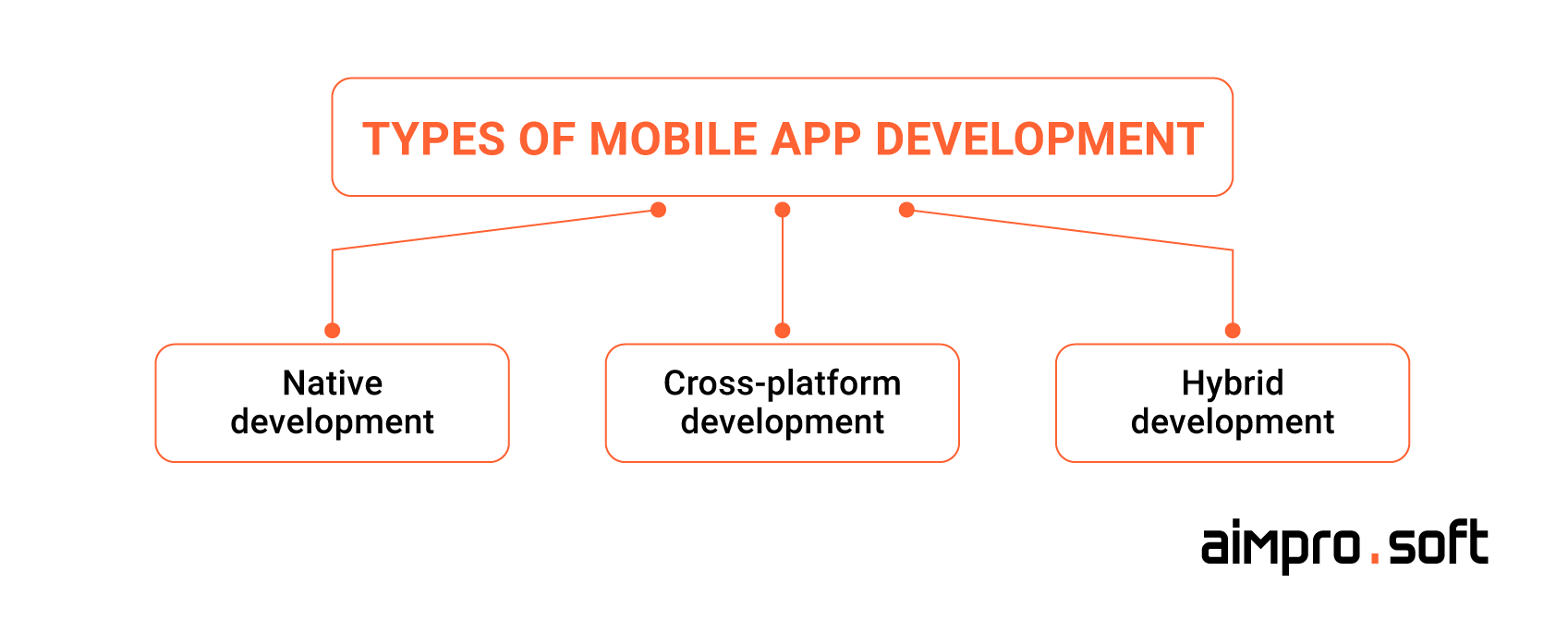
Types of mobile app development
Native app development
Native apps are developed for a specific platform, such as iOS or Android, utilizing platform-specific languages like Swift and Objective-C for iOS and Kotlin or Java for Android. These apps provide optimal performance and access to platform-specific features, delivering a seamless user experience. Native development involves direct usage of device capabilities, resulting in high performance and responsiveness. The development process, however, requires separate codebases for each platform, demanding more time and resources. Native apps are deployed through platform-specific app stores like App Store and Google Play, reaching a broad user base.
When do you need a native app?
Creating native applications has both advantages and disadvantages. For example, developers have direct access to the device’s hardware characteristics, allowing them to integrate advanced features using GPS, cameras, and sensors. Native apps also have platform-specific security measures that make them less vulnerable than their cross-platform counterparts. If your app relies heavily on platform-specific features or requires deep integration with the operating system, native development is essential.
However, such applications still have one significant downside – native development is usually more expensive due to the need for separate code bases for each platform, specialized expertise, and longer development times.
What kind of specialists are needed to develop a native app?
- Android developers
These professionals work with programming languages such as Java or Kotlin to create applications designed for Android devices.
- iOS developers
They use Swift or Objective-C programming language to create applications designed for iPhone and iPad devices running iOS.
Hybrid app development
Hybrid apps combine elements of both native and web apps. Developed using web technologies like HTML, CSS, and JavaScript, they are wrapped in a native container for distribution. This approach allows developers to use a single codebase for multiple platforms, reducing development time and effort. However, the reliance on web technologies may result in performance limitations compared to native apps. Hybrid apps can be deployed through app stores, providing a wide distribution channel.
When do you need a hybrid app?
Hybrid development is suitable for applications that need to run on multiple operating systems and projects with limited development budgets and timelines. Hybrid development is also suitable for prototyping and simple applications like information brochures, internal corporate tools, or small games.
What kind of specialists are needed to develop a hybrid app?
- Mobile app developers
Mobile app developers specialize in hybrid frameworks such as React Native, Xamarin, Flutter, or Cordova. They are in the business of writing code that can run on different platforms.
- Web developers
Web application developers may also be involved in hybrid development, mainly using a web-based approach (e.g., Cordova). Many hybrid frameworks use JavaScript or TypeScript. Developers who specialize in these languages can easily get involved in hybrid development.
Cross-platform app development
Cross-platform applications are created using frameworks such as React Native or Flutter. They run on multiple platforms with a joint code base, simplifying development and minimizing maintenance efforts. These frameworks allow developers to write code in a common language, such as JavaScript (React Native) or Dart (Flutter), and deploy it across platforms. Cross-platform development allows you to find a balance between performance and efficiency. Also, choosing such a platform for development can significantly reduce costs due to using a joint code base.
When do you need a cross-platform app?
Cross-platform development is primarily needed when you need to release your product quickly and if your budget is limited. Cross-platform frameworks like React Native, Flutter, and Xamarin enable developers to use a single codebase for both iOS and Android platforms. This eliminates the need to maintain separate codebases for each platform, saving time and effort. Cross-platform development also allows companies to allocate resources more efficiently, as the same team can work on both platforms simultaneously, resulting in significant cost savings compared to native development.
What kind of specialists are needed to develop a cross-platform app?
- Cross-platform developers
Specialists who specialize in using cross-platform development frameworks such as React Native, Xamarin, Flutter, or other similar technologies.
- Web developers
Developers with expertise in web technologies like HTML, CSS, and JavaScript. They can use their skills to build cross-platform applications using frameworks like Cordova or Ionic.
- Mobile developers
Developers who have experience building native apps for specific platforms (Android or iOS) can also be involved in cross-platform development to extend the reach of their apps.
Data Science
Data science is a dynamic scientific field focused on comprehending both structured and unstructured data to uncover valuable insights. Simon Data’s CEO predicts that the number of data scientists will grow by 36% between 2023 and 2031, making it one of the fastest-growing types of professions in the USA. Big data science encompasses diverse studies, methods, technologies, and tools, including machine learning, AI, deep learning, and data mining. Rooted in data analysis, statistics, mathematics, and programming, data science emphasizes data visualization and interpretation.
In the context of software solution development, data science plays a vital role throughout the entire process. From the very beginning of a project, data scientists contribute by defining objectives in line with business needs and ensuring that the necessary data is available. Data scientists use machine learning algorithms to create models during the model development phase. These models, designed to enhance functionality or make decisions within the software, are subjected to rigorous testing and validation. AI development, machine learning, and deep learning are integral components of the broader field of data science. Let’s look at key catgories together and see how many types of developers are there.
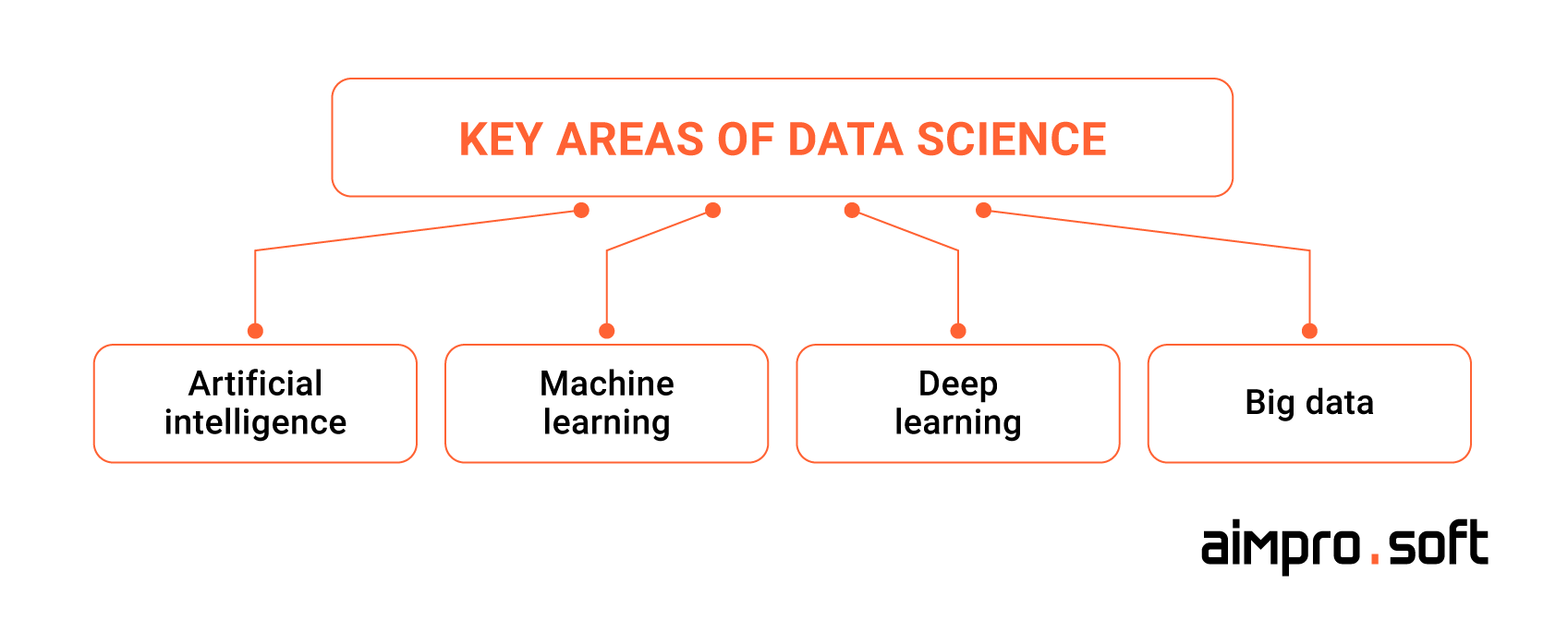
Key areas of data science
AI development
In a conventional context, artificial intelligence (AI) refers to algorithms, code, or methods enabling machines to imitate, evolve, and demonstrate human cognition or behavior. AI systems encompass functions such as learning, planning, reasoning, decision-making, and problem-solving. The AI development process often involves the collaboration of interdisciplinary teams, including data analysts, machine learning engineers, and subject matter experts.
Essentially, algorithms, machine learning techniques, and advanced analytics are used in the context of AI-powered product development to enable systems to perform tasks that typically require human intelligence. The main goal is to create intelligent systems that learn from data, adapt to changing conditions, and continuously improve performance.
What type of projects are AI technologies used for?
Artificial intelligence technologies are being widely used, particularly in the creation of chatbots. By understanding speech and natural language text, AI systems interact with people in a personalized and natural way. AI also plays an important role in a variety of fields, including applications for autonomous vehicles, robotics in manufacturing, and the development of filters to combat email spam.
What types of software developers are needed to develop AI projects?
- Data scientist
The Data Scientist usually analyzes data, develops models, conducts statistical analysis, creates data visualizations, and implements predictive modeling.
- AI engineer
The AI Engineer typically develops algorithms, designs system architecture, implements AI solutions, integrates AI into systems, and optimizes AI algorithms.
- Machine learning engineer
The Machine learning engineer focuses on developing ML models, preprocessing data, engineering features, deploying models, and monitoring and maintaining models.
Machine learning
Machine learning encompasses a collection of techniques, instruments, and computational algorithms employed to educate machines in scrutinizing, comprehending, and uncovering concealed patterns within data, enabling them to formulate predictions. The ultimate objective of machine learning is to leverage data for autonomous learning, negating the necessity for explicit programming of machines. After being trained on datasets, machines can employ acquired patterns on novel data, thereby enhancing their predictive capabilities.
The process of developing machine learning typically involves stages such as problem formulation, data collection, data preprocessing, model selection, training, evaluation, deployment, and ongoing monitoring. All these stages aim to create a system that can generalize well to new, unlearned data and adapt to changing conditions. The main goal of machine learning is to enable the software to recognize patterns, learn from them, and apply the knowledge to make informed decisions or predictions.
What type of projects is ML used for?
Machine learning usage examples include applications in the medical field that utilize electronic medical records and claims to predict the likelihood of patients falling ill. Additionally, machine learning is exemplified in fraud detection systems, which identify potential fraud instances through the analysis of suspicious user behavior. In the same way, machine learning can be used for recommendation systems. ML algorithms analyze user preferences to recommend movies, music, products, or content based on individual tastes.
Machine learning can also be used to implement a wide range of functions, such as developing NLP algorithms and extending software products with functions such as sentiment analysis, chatbots, and language translation. Machine learning models can also predict future trends and outcomes based on historical data, providing software products with predictive decision-making analytics.
Which specialists develop solutions based on machine learning?
- Machine learning engineer
Such specialist designs algorithms, translates models into software, integrates them into production, and optimizes for efficiency.
- Data scientist
Data scientist analyzes datasets for trends, develops predictive models based on historical data, performs statistical analysis to validate findings, and creates visual representations for effective communication.
Deep Learning
Deep learning, a subset of machine learning, advances through intricate neural networks, drawing inspiration from the complex structure of biological neural networks found in the human brain. These networks consist of interconnected layers of nodes that collaborate to comprehend extensive input data.
Considering the deep learning process, we can look at the picture below. The images show the faces of Chihuahua dogs and cupcakes and biscuits, and our brains can easily distinguish one from the other. For machines, the process of recognition can be a difficult task. To determine what is depicted in the pictures and produce accurate results, they must learn vast amounts of data, create algorithms, and convert the input data into machine-readable forms. Image generation and image classification are popular applications of deep learning.

The process of recognition
The key design considerations for deep learning projects are selecting an appropriate deep learning architecture, training the model, and evaluating its performance. Fine-tuning the hyperparameters improves the model’s performance. After training, the model is run to make predictions on new data.
What type of projects is deep learning for?
Deep learning is widely used for recognizing objects and patterns in images and speech, recognizing faces and voice commands, such features are again often included in chatbots. For language-related tasks, including sentiment analysis, language translation, and chatbot development, by understanding and generating human-like text. Deep learning is also used to develop games for quality gameplay by creating realistic characters, animations, and environments. It also plays an essential role in improving virtual reality applications.
Which types of software developer develop solutions based on deep learning?
- Machine learning engineer
This specialist creates, builds, and deploys machine learning models, works with large datasets for training and optimization, collaborates with data scientists to develop AI models, implements machine learning algorithms, and ensures models are scalable and efficient.
- AI engineer
AI engineer generally focuses on a broader set of tasks encompassing various forms of machine intelligence, including neural networks. They research, build, and design self-running artificial intelligence (AI) systems, develop AI models for diverse applications beyond traditional machine learning, and may work on tasks related to computer vision, natural language processing, and other AI domains.
Video game development
This software development type is the process of creating games for various platforms, including consoles, desktops, and mobile devices, that fulfill users’ needs for an engaging visual and auditory experience. The scale of development varies greatly, from a few developers to large teams, with projects taking months or even years to complete. Depending on the game’s complexity, video game development may be quite an expensive and time-consuming process. Let’s examine the two most popular game development engines that are usually used by developers.
Unreal Engine
The Unreal Engine, developed by Epic Games, is known for its high-end graphics and realistic visuals. Unreal Engine uses Blueprints, a node-based visual scripting language, making it accessible to those with little programming experience. It also supports the C++ language for more complex programming. Unreal Engine is known for its real-time rendering capabilities and is a popular choice for projects that require advanced graphics and immersive environments.
What type of projects is this game engine used for?
Unreal Engine is used in diverse training scenarios, including military training simulations, medical training simulations, and industrial training modules. This game engine is also used for AAA game development and architectural visualization.
Which specialists develop games using this technology?
- Game developer
Encompasses professionals involved in various aspects of game creation, including programming, design, and implementation, often using engines like Unreal.
- Sound engineer
Sound specialists develop realistic sound effects, record voiceover dialogue between characters, create soundtracks that set the mood for players, and add suspense or sound cues.
- FX artists
FX artists enhance the gaming experience by incorporating captivating effects like explosions, smoke, fire, liquid simulations, and various weather conditions such as rain, lightning, and blizzards.
Unity Engine
Unity, developed by Unity Technologies, is a versatile game development engine suitable for various platforms. It is known for its ease of use and flexibility, making it accessible to start-up game development companies and experienced organizations. Unity uses C# as its primary scripting language, balancing simplicity and features. Unity’s asset shop allows developers to access an extensive library of ready-made assets to simplify development.
What type of projects is this game engine used for?
Unity Engine’s versatility extends beyond gaming into various domains, making it a popular choice in diverse industries. It is used in large projects, such as in indie games, mobile games, and apps. It also includes the ability to develop desktop games and VR games.
Which specialists develop games using this technology?
- Game programmer
Game programmers translate design concepts into code for complete games. Typically, they are skilled software engineers or computer scientists with a strong programming background, creativity, mathematical proficiency, and patience. Their primary responsibility is to bring ideas to life through interactive visual and sound effects, ensuring the smooth functionality of the game.
- Game designer
A game designer serves as the creative force behind a game, blending aspects of a writer and an artist with some programming knowledge. Designers handle various responsibilities, including developing storylines, character details, dialogue, gameplay, rules, scoring systems, and difficulty levels, and designing environments, obstacles, and objects.
- 3D modeler
A 3D modeler produces models of various elements like people, objects, props, weapons, and environments, which are later textured and animated. They use reference materials such as photos or drones for larger objects and rely on concept art for fantasy games, employing their creativity to craft original designs.
Desktop development
Desktop development involves creating applications specifically designed to operate on desktop operating systems, including Windows, macOS, or Linux. These applications are tailored to leverage the features and capabilities of desktop environments, offering users a robust and feature-rich experience. Whether it’s for business applications, content creation tools, or specialized software, desktop development ensures optimal performance and functionality within the context of a desktop operating system. This approach allows developers to harness the full potential of the underlying hardware and provide users with applications that seamlessly integrate into their desktop workflow.
What type of projects desktop development is best suited for?
Desktop apps are most relevant for developer tools, content creation and editing, offline applications, and security-critical systems.
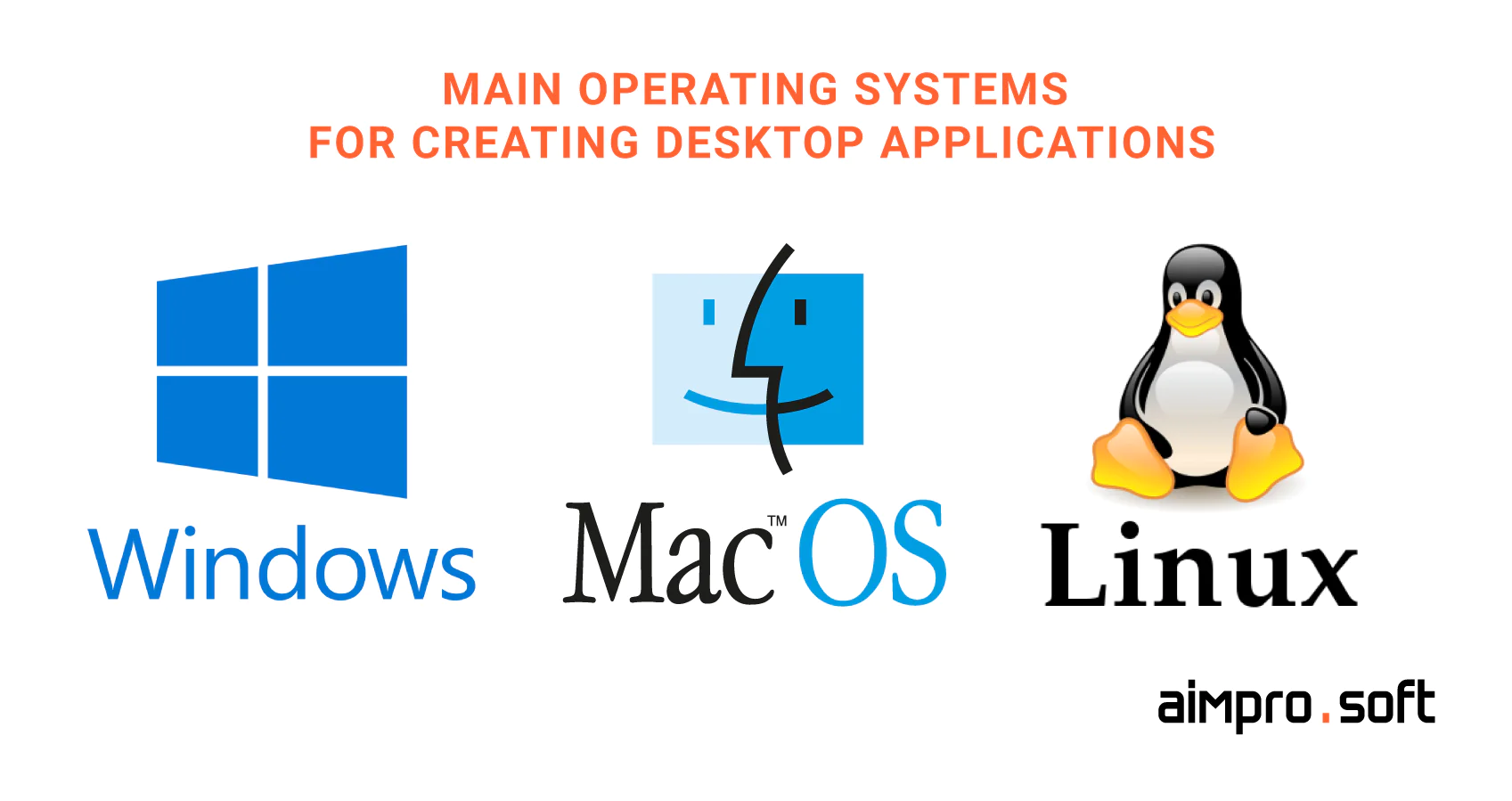
Main operating systems for creating desktop applications
Windows development
Windows development refers to creating software applications designed to run on the Microsoft Windows operating system. Windows is a robust and widely used application development platform that supports various programming languages such as C++, C#, and .NET. The Windows development environment includes tools such as Visual Studio, a comprehensive, integrated development environment (IDE) for creating applications and desktop programs. Development on Windows allows building software that targets a wide range of users who use Windows PCs and devices.
When do you need to build a product for this operating system?
Windows desktop applications have several advantages in specific contexts. For example, if your product requires complex design elements, sophisticated interaction, or a consistent look and feel with Windows. Likewise, for applications that require high performance and applications with specific tasks such as graphic design tools, 3D modeling, or complex data analysis.
What kind of specialists are needed to develop solutions for Windows?
To create desktop applications for Windows, you usually need developers with specific skills such as C++ or C# or knowledge of frameworks such as ElectronJS. Also, such developers should have experience with technologies like .NET Framework or the Windows Desktop Application Development Guide.
MacOS development
MacOS development is creating applications for Apple’s macOS operating system, which runs Macintosh computers. Developers often use languages such as Swift and Objective-C, as well as the Xcode development environment, to create applications for macOS. The macOS platform is known for its user-friendly interface, and its applications are optimized to provide a user-friendly and intuitive interface for Mac users.
When do you need to build a product for this operating system?
MacOS desktop application development can benefit projects if your target audience consists mainly of macOS users. Suppose your application requires deep integration with macOS-specific features or functions such as Siri integration, Touch Bar support, or iCloud synchronization. In that case, desktop application development ensures optimal use of these features. MacOS is also known for its robust security features. If your application handles sensitive data or requires high security, developing your own macOS desktop application will allow you to utilize the platform’s security protocols.
What kind of expertise do you need to develop solutions for macOS?
Developers creating desktop applications for macOS should use specific tools and languages. Swift and SwiftUI is Apple’s official language and framework for developing applications for macOS. Such developers also have experience with development environments like Xcode. Developers can also use to build desktop applications for macOS languages such as Python and C#.
Linux development
Linux development is the creation of software applications for the Linux operating system, a popular open-source platform widely used in server environments, embedded systems, and developer workstations. Linux supports various programming languages, and development tools depend on individual preferences. Common languages include C, C++, Python, and others. The open nature of the Linux community fosters the ongoing development of Linux development practices.
When do you need to build a product for this operating system?
Linux desktop application development is suitable in such scenarios; for applications designed for devices or environments where resource efficiency is crucial, Linux can optimize performance. This operating system also suits business-oriented products or enterprise solutions and needs compatibility with Linux servers. Linux is widely used in enterprise environments, especially for server deployments.
What kind of specialists are needed to develop solutions for Linux?
To create desktop applications for Linux, you need developers with these skill sets: Python and C/C++. These languages provide low-level control and high performance, making them suitable for Linux development. They should also have knowledge of Qt Framework, which is useful for applications written in C and C++ as it provides cross-platform support.
Cloud computing development
Cloud development is the process of creating applications that utilize cloud computing resources. Also, this approach involves seamless deployment using cloud platforms. Key technologies include scalable cloud infrastructure like AWS or Microsoft Azure, pay-as-you-go models, collaboration tools, and global deployment. Unlike traditional development, cloud development has increased scalability, flexibility, and cost-effectiveness, making it optimal for today’s globally distributed applications. It utilizes scalable infrastructure, supports microservices architecture, and enables global collaboration through cloud platforms. The pay-as-you-go model minimizes upfront costs, while the ability to dynamically scale resources optimizes performance.
Multi-cloud
Multi-cloud development refers to simultaneously utilizing multiple cloud providers’ services and resources to build and deploy applications. Multicloud involves a strategic approach to distributing workloads across different cloud platforms.
Developing multi-cloud solutions suits organizations interested in improving operational resilience and flexibility. A multi-cloud approach allows for the integration of different cloud services. This increases agility and scalability, allowing companies to tailor the cloud environment to meet specific needs. The ability to selectively utilize cost-effective services from different providers managed through a single platform protects businesses from vendor lock-in.
What kind of specialists are needed for multi-cloud development?
- DevOps specialists
On multi-cloud projects, DevOps specialists implement automation tools (Terraform, CloudFormation) to configure and deploy infrastructure in various cloud environments. This specialist also works on security strategies, integrating best practices for identity management, access control, and data encryption in multi-cloud environments. DevOps also provides interactions between development and operations teams.
- System administrators
These professionals control the configuration and maintenance of infrastructure components, including servers, networks, and storage, ensuring compatibility with multi-cloud environments. They also implement automatic scaling and load-balancing mechanisms to optimize resource utilization and accommodate changing workloads.
Hybrid cloud
Hybrid cloud development involves integrating on-premises infrastructure and cloud services to create a unified and flexible computing environment. A hybrid cloud is a blend that enables seamless data and application sharing between on-premises and cloud environments.
Suitable for businesses looking to strike a harmonious balance between legacy infrastructure and modern cloud capabilities, the development of hybrid cloud solutions is invaluable. This approach allows companies to keep sensitive data in on-premises data centers secure and compliant while leveraging the flexibility and innovation of public cloud services. In addition, the hybrid model can significantly reduce infrastructure costs by eliminating the need to dedicate significant resources to centralize all data.
- Cloud engineer
Implements the hybrid cloud infrastructure, working on the integration of on-premises systems with public cloud services. Focuses on scalability, performance, and reliability.
- DevOps specialists
Leverage cloud-bursting to efficiently scale resources based on demand. Safeguards applications and data by adopting a hybrid cloud strategy.
DevOps engineering
DevOps engineering is a holistic approach that seeks to bridge the gap between software development (Dev) and IT operations (Ops). A DevOps engineer is an IT professional with a diverse skill set encompassing both development and operations. Aligned with Agile practices, this approach has gained extensive adoption among global developers and software development teams.
DevOps engineers operate within teams that embrace these principles, engaging in product development, testing, quality assurance, and subsequent deployment. While there is a certain level of programming in this practice, the role of DevOps professionals goes far beyond just writing code because it encompasses a broad set of rules and responsibilities. Their skill set encompasses a diverse range, including programming, integration, scripting, and QA testing. The ability to seamlessly blend theoretical knowledge with practical application is crucial, as they collaborate with various team members, including software developers and QA specialists, to facilitate a cohesive and efficient workflow.
When is DevOps needed?
The DevOps approach is suitable for a wide range of projects like enterprise products, web applications, and SaaS, as well as for such cases where a cloud environment is used. In all these scenarios, the DevOps is essential.

Apart from DevOps, what specialists may be needed on projects with a DevOps approach?
- DevSecOps engineer
DevSecOps, an extension of the DevOps approach, integrates security practices into the entire software development lifecycle. The DevSecOps specialist plays a critical role in this paradigm, ensuring that security is not treated as a separate phase but is seamlessly woven into each phase of development.
- Network engineer
Network engineer handles network configurations, ensuring seamless communication between different system components.
- Containerization specialist
Containerization specialist manages containerized environments, often using tools like Docker, to enhance consistency across different environments.
Want to learn more about the benefits of using the DevOps approach on a project? Read our article on the topic to discover more about it.
Embedded systems development
An embedded system is a specialized computer system designed to perform specific functions as part of a more extensive system. This type of software development is a combination of hardware and software components that work together to achieve a predetermined set of tasks. Embedded systems are designed to control equipment, process sensor data, or manage communication protocols. Embedded system development involves designing and building specialized computing systems to perform specific functions.
An example of embedded system development is the creation of software for controlling smart home devices like thermostats, lighting systems, and security cameras, providing automation and remote control capabilities.
What software developer types are needed to develop embedded systems?
- Software engineer (senior)
An embedded systems developer must have knowledge of specific programming languages like Java, Python, or Ruby. The essential skill for the job is also the ability to work with hardware and, more specifically, to interact with its APIs (software interfaces).
Security engineering
Security engineering is an interdisciplinary field that presupposes the creation of robust systems in the face of malicious acts, errors, and failures. This discipline involves designing, implementing, and testing complex systems and adapting them to changing conditions. Interdisciplinary expertise covering areas such as cryptography, computer security, hardware tamper-proofing, organizational behavior, and law is essential. While systems engineering skills are necessary, they alone are not sufficient to counter malicious threats.
When do you need an approach like security engineering?
Security engineering is critical for projects that involve sensitive information such as personal data, financial records, or proprietary information, requiring a robust security engineering approach. Such an approach is also required for systems integral to critical infrastructure, such as power grids and transport networks. Failures in such systems can have serious consequences, so their security is paramount. Security engineering is crucial for financial projects, including banking systems, payment gateways, and stock exchanges.
What specialists are needed to implement products with a security engineering approach?
- Security engineer
The security engineer implements robust security measures and performs penetration testing and system assurance. Resolves security issues and develops strategies for recovering from data breaches.
- Penetration testers
They identify vulnerabilities by simulating cyberattacks.
- Security analysts
Such specialists analyze security data, monitor threats, and implement measures to improve security.
Contact us, and our specialists will help you to decide which one to choose.
CONTACT USWrapping up: which type of development suits your project best?
We have explored different types of software development, the specifics of each field, and the circumstances in which each type is best suited. But how to figure out what types of specialists are required for your project?
When selecting the type of specialist for a project, you should focus on the nature of the product, its requirements, and your business goals. Then, there are factors such as the scope, complexity, and desired features of the project, which play a crucial role in making the right choice.
If you still need help deciding which type of experts are necessary for the implementation of your idea, you should contact a reliable software provider. Such a vendor will assess your needs and your business goals and will be able to make a balanced and clear recommendation on types of developers in software. For example, at Aimprosoft, we have over 350 IT professionals on board who have experience in web and mobile application development, cloud computing, data science, and many other fields. Given our vast experience gained over 18 years in the IT industry, you can contact us, and we can bring your project to life and help you assemble the best team.
FAQ
What is software development?
Software development is the systematic process of designing, creating, testing, and maintaining computer programs and applications. It encompasses a range of activities, including planning, coding, testing, and debugging, to produce reliable and efficient software solutions. The software development life cycle (SDLC) provides a framework for managing these processes, guiding developers from the initial concept to the deployment and maintenance of the software.
What are the key differences between native and hybrid app development?
Native app development involves creating applications tailored to a specific platform, such as iOS or Android, using platform-specific languages (Swift or Kotlin). In contrast, hybrid app development employs a single codebase, often written in web technologies like HTML, CSS, and JavaScript, which can run on multiple platforms. The primary distinction lies in performance and user experience; native apps typically offer better performance and seamless integration with the device’s features, while hybrid apps provide cross-platform compatibility, enabling cost-effective development for both iOS and Android.
What are the primary characteristics of embedded software development?
Embedded software development involves creating software designed to operate within embedded systems, which are dedicated computing devices often built into larger systems or products. The primary characteristics of embedded software development include real-time operation, where the software must respond to external stimuli within a specified timeframe, low-level hardware interaction to optimize system performance, and resource constraints that demand efficiency in memory and processing power usage.




